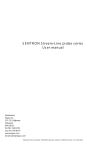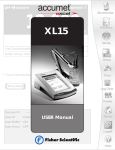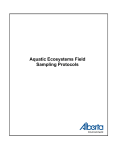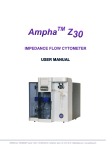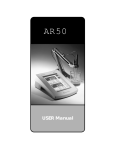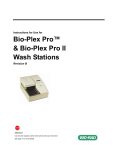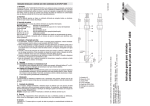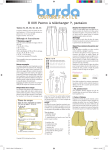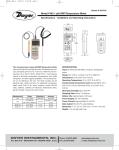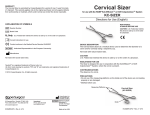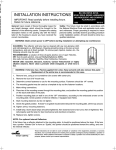Download accuFet™ XL Solid-State pH Probe Series User Manual
Transcript
INSTRUCTIONS accuFet™ XL Solid-State pH Probe Series User Manual 1 INTRODUCTION Congratulations! You have just bought a accuFet™ XL Solid State probe; one of the finest pieces of pH-measuring equipment available in the world today. With proper care and following the given instructions you are likely to enjoy the benefits of your accuFet ™ XL Solid State pH-system for a long time. The accuFet™ XL Solid State series are a series of probes for use in general purposes but also in demanding applications, where elevated sample temperatures, up to 105°C (Lance Tip only up to 60 °C), or contact with more aggressive chemicals are to be expected. Within the accuFet™ XL Solid State series there are three different probe-tip types available: - Cup Tip, for general purpose use and for very small sample volumes. - Cone Tip, for application in highly viscous materials, jellies, pastes, slurries, pulps water-based polymer-emulsions etc. - Flat Tip, for direct surface measurement in paper industry, water based printing inks, paints, coatings etc. - Lance Tip for application in semi-solids: fruit, meat, fish, soil etc. All accuFet™ XL Solid State pH-probes contain an Ion Sensitive Field Effect Transistor (ISFET) sensor, a silver/silver chloride – potassium chloride reference system and a thermistor for Automatic Temperature Compensation (ATC). Each probe also has an identity of its own, a “fingerprint” so to speak, enabling your accumet meter to identify your (new) probe’s fingerprint through calibration. 2 CLEANING TIPS 2.1 Soapy water method for cleaning the probe To have most pleasure of your probe, good cleaning is a must! If the probe is not properly cleaned it can happen that the probe does not work due to a polluted diaphragm or ISFET. The fluid in which you are measuring can cause this. Is the probe not cleaned regularly, the diaphragm will block the internal electrode. In such 68X068047 rev 0, 05/2004 accuFet™ XL Solid-State Instruction Manual 1/8 case there is no electrical contact between the electrode and the ISFET-chip and the probe will not work properly. To prevent this, you must clean the probe regularly. The frequency is depending of the sample you are measuring in. As reference: it is mostly also visible, the diaphragm is no longer white! 2.2 Cleaning Put the probe in soapy water with a constant temperature of 60°C for minimal 5 minutes. Then start cleaning the probe with the toothbrush. After this the probe must be placed in a KCl-solution with a temperature of ± 20°C for ½ hour. This ‘cold’ KCl-dip will regenerate the reference system and the diaphragm. 3 SAFETY AND CARE. The pH-sensitive element in a accuFet™ XL Solid State probe is an ISFET semiconductor. This sensing element needs to be driven by an electronic circuit that is built into the accumet pH meters. This probe can only perform up to its specification when used in combination with one of the accumet pH-meters. Any other combination might cause loss of performance and irreversible damage to both probe and meter. The fact that accuFet™ probes are ruggedly build to last, even in harsh conditions, does not mean that the probe needs no maintenance at all. Read the operating tips well, to ensure lasting satisfaction. Also do note the following: 1) Tris buffers and samples containing proteins should be read quickly and the probe should be rinsed thoroughly with deionized water between samples. When testing is complete, clean with water and a laboratory detergent and rinse with deionized or distilled water. 2) Avoid prolonged immersion in samples containing Tris or proteins. 3) Samples must be compatible with polycarbonate / ABS plastic and epoxy. Do not use in hydrofluoric acide, DMF (n,n dimethylformamide), MEK (methylethylketone) or related solvents. 4) Avoid prolonged immersion in samples expected to have pH-values at the ends of the specified pH-range or temperature range. This may shorten the probe’s lifetime. 5) When unavoidable, rinse with ample water in between samples. Rinse with neutralizing agents and distilled water when the measurement is completed and prior to storage. 6) Do not use the probe outside the specified temperature range as this might result in probe failure or irreversible damage to the probe. Note: Lance Tip probe’s temperature range is up to 60 °C. 7) Samples must be aqueous solutions or semi-solids and compatible with the probes wetted materials. 68X068047 rev 0, 05/2004 accuFet™ XL Solid-State Instruction Manual 2/8 4 DAILY USE 1) Remove and save the protection tube from the probe prior to use. 2) Prior to daily use, scrub the probe tip with a soft bristled toothbrush and water to remove possible residues. Use some mild detergent if required. 3) Reference gel may be observed as a viscous material on the tip of the probe. Some gel seepage from a new probe is normal and will not affect the longevity or performance of the probe. 4) Rinse with deionized or distilled water. Soak the probe in pH 7.00 buffer or pH 4.00 buffer with the meter ON (in any mode) prior to calibration for at least 10 minutes. 5) If the probe has not been used for two or more days and stored dry, clean as above, place in saturated KCl solution (See Tip 1) for 10 to 15 minutes, then in pH 7.00 or pH 4.00 buffer as described above. 6) For maximum stability and accuracy, perform the calibration sequence twice. 7) To store the probe, clean it thoroughly with water and a soft bristled toothbrush (again, a mild detergent may be used) and rinse with deionized or distilled water. Replace the protective tube. When doing so, slide the screw-cap onto the probe body, followed by the sealing O-ring. Slide cap and ring onto the rim of the protective tube, press slightly and only then tighten the screw-cap. 8) Leaving a drop of deionized or distilled water in the protective tube provides a humid environment, avoids dehydration of the reference electrode and therefore allows for faster start-up times. Note: When used in samples containing small hard particles (e.g. pigments, titanium oxides, silicates etc.) first rinse the probe with ample water before using the brush. 5 OPERATING TIPS Tip 1: To prepare saturated KCl (potassium chloride) solution: Add KCl-granules to distilled water until no more KCl will dissolve. Adding 38 grams of KCl to 100 ml water is sufficient. Let this stand for at least two hours and decant the clear solution. Now you have saturated KCl. Tip 2: To ensure correct measurement values, samples or buffers need to be mixed well. This may be done by a magnetic stirrer or by stirring with the probe for at least 5 seconds. Stop stirring and record results when the read-out is stable. Tip 3: Proteins, fats and oils may be removed by scrubbing in a solution of Terg-A-Zyme (Alconox company), a pepsin solution 68X068047 rev 0, 05/2004 accuFet™ XL Solid-State Instruction Manual 3/8 or a similar product. Afterwards, rinse thoroughly with deionized or distilled water. Do not use hydrofluoric acid, acetone, MEK or similar agents to clean the probe. Tip 4: When testing in direct sunlight or on a bright reflecting surface, please use brown, opaque or shielded sample containers. Very bright light might influence the performance of the sensor. Tip 5: Buffer-handling: pH 7.00 buffers (phosphate-based) and pH 4.00 buffers (biphtalate-based) are less susceptible to carbon dioxide contamination than pH 10.00 buffers (borax or carbonate based). When slope errors occur, it usually indicates a failing probe or a contaminated buffer. If you witness this while using pH 10.00 buffer, try calibrating with pH 7.00 and pH 4.00 buffer. If a good slope is achieved, try a new bottle or different lot pH 10.00 buffer. Fresh buffers are available at Fisher Scientific, ask your local dealer. Tip 6: Cone Tip and Lance Tip are designed for use in semi-solids or solutions. When using with semi-solids, insert probe to desired depth, then rotate left and right several times and tilt to ensure sample contact. Tip 7: To avoid scratches on the chip and/or epoxy it is advised only to use the toothbrush after cleaning procedure in the soapy water or after rinsing the probe in water. Most scratches cause when there are hard pieces in the sample and on the ISFET. Together with the toothbrush these hard pieces can cause scratches on the surface of the chip and damage the epoxy around the chip, which can give bad readings. 6 GENERAL 1) Reference gel may be observed as a viscous material on the tip of the probe. Some gel seepage from a new probe is normal and will not affect longevity or performance. Clean as above. 2) Samples MUST BE aqueous liquids or semi-solids. Rinse with deionized or distilled water between samples. 3) To ensure mixing, stir samples or buffers for 5 seconds with the probe or a magnetic stirrer, stop stirring and record results when stable. 68X068047 rev 0, 05/2004 accuFet™ XL Solid-State Instruction Manual 4/8 4) Proteins, fats and oils may be removed by scrubbing in a solution of Terg-A-Zyme (Alconox Company), Neutrad® or Neutracon (Decon Laboratories), pepsin solution or similar product. Rinse thoroughly with deionized or distilled water. 5) Spare probes should be rotated with those in active use every 30 – 60 days to minimize reference junction dehydration and reduce initial start-up time. 6) Buffers. pH 7.00 (phosphate) and pH 4.01 (biphthalate) buffers are less susceptible to CO2 contamination than pH 10.01 buffer (borax or carbonate). When slope error occurs, it usually indicates a failing probe or contaminated buffer. If seen when using pH 10.01 buffer, try calibrating with pH 7.00 and pH 4.01 buffer. If a good slope is achieved, try a new bottle or different lot of pH 10.00 buffer. 7) When testing in direct sunlight or on a bright, reflective surface, use brown, opaque or shielded sample containers. 7 TROUBLE SHOOTING If any of the following events occur: low slope, drift, instability of the reading, slow calibration, probe will not calibrate, pH value doesn’t change as expected when changing samples: - Put the probe in soapy water with a constant temperature of 60ºC for minimal 5 minutes. Then start cleaning the probe with the toothbrush. After this the probe must be placed in a KCl solution with a temperature of ± 20ºC for ½ hour. This ‘cold’ KCl-dip will regenerate the reference system and the diaphragm. 68X068047 rev 0, 05/2004 accuFet™ XL Solid-State Instruction Manual 5/8 8 SPECIFICATIONS Sensor: Semi-conductor Ion Sensitive Field Effect Transistor (ISFET) sensor with patented ESD protection circuit. Operating temperature: -5°C to 105°C (For Lance Tip – -5 to 60 °C) pH-range: pH 0 to 14 Reference compartment: Saturated KCl-gel, non-refillable Dimensions: Probe length: Probe diameter: Cable length: Connector: DIN Wetted materials: Barrel and tip: Packaging material: Reference liquid: Diaphragm: Chemical resistance: If doubts concerning applicability arise, please contact your local dealer. 200 mm 10 mm 1.5 meter PEI (poly ether imide) Epoxy-resin Gelled KCl Porous PTFE 9 STORAGE You can store the probes dry or for some days in KCl solution. If stored in a KCl solution the value of the pH measurement can be influenced by the KCl. To prevent this and to have a good measurement we advise you to clean the probe after the storage for some minutes (at least 5 minutes) in deionized water of about 25°C. 68X068047 rev 0, 05/2004 accuFet™ XL Solid-State Instruction Manual 6/8 10 WARRANTY This accuFet™ probe is produced, packed and shipped with the utmost care. If, the former notwithstanding, defects do arise, be advised that this accuFet™ probe is warranted to be free from defects in material and craftsmanship for the period of 6 months. Fisher Scientific will repair or replace, at own’s option, any defective part free of charge if this product fails within 6 months from the date of purchase, provided that the failure is due to defective material or lack of craftsmanship and has occurred under normal conditions of usage, to be judged by Fisher Scientific. Fisher Scientific disclaims any liability to customers, to users of its products, or to any other person or persons for any special or consequential damage that might arise out of, or that might in any way be connected with, the use of this probe The warranty described in this paragraph shall be in lieu of any other warranty, expressed or implied, including but not limited to any implied warranty or merchantability or fitness for a particular purpose. The buyer’s sole and exclusive remedy is for repair or replacement of defective parts as provided therein. All information contained in this manual is current at the time of publication. Our commitment to product improvement requires that we reserve the right to change equipment, procedures and specifications at any time. 68X068047 rev 0, 05/2004 accuFet™ XL Solid-State Instruction Manual 7/8 Electrochemical Questions? Call our Technical Specialists at: 1-888-358-4706 Email: [email protected] MODEL NUMBER ___________________ SERIAL NUMBER ___________________ PURCHASE DATE ___________________ 68X068047 rev 0, 05/2004 accuFet™ XL Solid-State Instruction Manual 8/8










